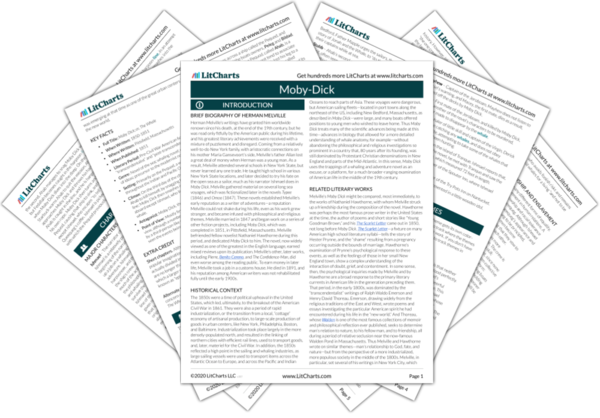Limits of Knowledge
One of the novel’s primary themes is that neither nature nor human life can be understood perfectly. At times during the voyage, the Pequod’s crewmembers reflect, with feelings ranging from cheerful resignation to despair, on the uncertainty of their fate. This uncertainty parallels the doubts of religious faith. Ishmael notably remarks that “our souls are like those orphans whose unwedded mothers die in bearing them: the secret of our paternity lies in their grave, and…
read analysis of Limits of KnowledgeFate and Free Will
Despite their awareness of the limits of human knowledge, Ishmael and other characters are often trying to interpret signs of the world around them in order to determine their fates. At the beginning of the book, Ishmael intimates that it was fate that led him to decide, after many merchant voyages, to sign up for a whaling ship—although at the time it felt like he was doing so of his own free will. Over the…
read analysis of Fate and Free WillNature and Man
The novel centers on man's multi-faceted interaction with nature, whether by trying to control or tame it; understand it; profit from it; or, in Ahab’s case, defeat it. The book implies that nature, much like the whale, is an impersonal and inscrutable phenomenon. Man tends to treat nature as an entity with motives or emotions, when in fact nature is ultimately indifferent to man. The cautious and pragmatic Starbuck is one character who…
read analysis of Nature and Man
Race, Fellowship, and Enslavement
The book explores many different forms of equality, fellowship, and enslavement in human relations. A notable example of fellowship and racial tolerance is Ishmael’s close friendship with Queequeg. Although Ishmael is initially repulsed and terrified by Queequeg’s appearance and background, he soon perceives Queequeg to be principled, loyal, affectionate, and talented. The two men become “married,” in Queequeg’s parlance, meaning that they vow to join their fates and lay down their…
read analysis of Race, Fellowship, and EnslavementMadness
Through the contrasting characters of Ahab and Pip, the novel presents two very different portraits of madness and its consequences. Throughout the voyage, Ahab’s madness holds sway over the sanity of other characters, most notably his reasonable and prudent first mate Starbuck. Insanity of a different kind is seen in Pip who, like Ahab, goes mad after a traumatic experience at sea. However, while Ahab’s madness propels him to action, Pip’s…
read analysis of MadnessReligion
Religion is a major point of reference for Ishmael. In New Bedford, before the voyage, he visits a “Whaleman’s Chapel” and hears a long and heated sermon, delivered by the stern Father Mapple, that centers on the story of Jonah and the whale. The sermon recounts Jonah’s futile attempt to flee God, and suggests that the harder Jonah tries to escape, the harsher becomes his punishment. Father Mapple emphasizes that, after being swallowed…
read analysis of Religion











